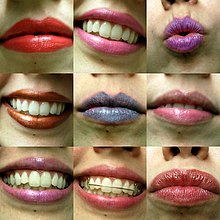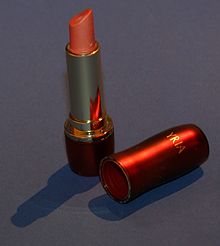lipstick
The lipstick is a cosmetic utensil for coloring the lips that was created in the 19th century and is mainly used by women.
history
The oldest find that suggests lip dyeing dates back to 3500 BC. During excavations in the Sumerian city of Ur , researchers discovered a type of lip ointment. It is well documented that queens like Nefertiti (around 1350 BC) not only put red make-up on the mouth, but also clearly emphasized the eyes. Colored lips were also quite common among men, especially warriors.
The Greeks in the fifth century BC, however, would never have to make-up can be seen in public. In their culture, only artists, heterosexuals and prostitutes colored their lips.
In ancient Japan , make-up was a duty for high-ranking women. The Japanese women used a mixture of wax , honey and pigments that came very close to the composition of modern lipsticks.
While it is unclear whether and how people used make-up in the Middle Ages, cosmetics were very popular in the Baroque era . Queen Elizabeth I emphasized her red lips by the contrast of her white powdered face. She is also said to have been the first woman to use pencil-shaped lip color. Queen Victoria ruled makeup was rude in 1860, in keeping with her puritan age.
In 1883, at the World Exhibition in Amsterdam, a perfume manufacturer from Paris presented a pen made of colored castor oil , deer tallow and beeswax wrapped in tissue paper . At first, however, he had a difficult position, as he was not only considered sinful, but also very expensive. French actress Sarah Bernhardt , a late 19th century diva, popularized lipstick when she stood on stage with a cherry-red mouth. Guerlain first put the lipstick in a metal tube in 1910. The triumphant advance of lipstick finally began in the Roaring Twenties . From 1948, designers wrapped it in a practical metal sleeve with a sliding mechanism so that the ladies only colored their lips and not their fingers or handbags. The Revlon -Brüder Charles and Joseph produced not only the first nail polish, but were also the first to introduce the color of the nails with one another for the lips voted. The American chemist Hazel Bishop developed the lipstick based on lanolin , which is still used today , and which does not allow the color to smear. A private lipstick museum was opened by René Koch in Berlin.
composition
The materials from which the lip color was made were as varied as the history was changeable. While the Egyptians applied ocher and colored juices with reeds , Queen Elizabeth I used a mixture of alabaster , plaster and colored particles. These days lipsticks are made from oils, waxes, pigments and other chemicals. The shelf life required for kissable color has not yet been achieved in natural cosmetics . Earlier, the red pigments (were Carmine ) and from the cochineal - cochineal won.
use
There are various applications and forms of use around the world, some of which differ greatly from those commonly used in Europe. In regions of Africa, such as the Wodaabe and Tuaregs , men color their lips black; sometimes with toxic waste, such as used alkaline batteries. In India, hijras are very noticeably applying makeup to their lips and eyes. In addition, in some ethnic groups or ideologies, wearing lipstick is frowned upon.
Economic factor
Lipstick products are important economically. The market for lip cosmetics remains largely stable even in economic crises.
literature
- Rene Koch: Lucky Lips: History (s) about lipstick. With care tips & tricks. (Photos by Brigitte Dummer), new edition, Buchverlag für die Frau, Leipzig 2009, ISBN 978-3-89798-229-1 .
- Sabine Gieske, Frank Müller, Virginie Brager: lipstick. A cultural and historical foray into the mouth. Jonas Verlag , Marburg 1996, ISBN 3-89445-204-8 .
- Meg Cohen Ragas, Karen Kozlowski, Meg Cohen Ragas: Read My Lips. A Cultural History of Lipstick. Chronicle Books, San Francisco 1998, ISBN 0-8118-2011-4 (English).
- Sven Tode, Mathias Eberenz: Ingenious from Hamburg. From invention to brand: lipstick and toothpaste, slide rule and ink pen. Hanseatischer Merkur, Hamburg 2006, ISBN 3-922857-33-7 .
See also
Web links
- What's that stuff? - Lipstick Chemical & Engineering News, July 12, 1999, Volume 77, Number 28 General Understandably article in the members' magazine of the American Chemical Society (English)
- The history of lipstick from ancient times 3500 BC Until today. In: der-beauty-blog.de
- 125 years of lipstick - a rush in red. In: one day / Spiegel-Online
Individual evidence
- ^ Berger - Cultural Representation among the Wodaabe Nomads
- ↑ Between the Lines - India's third gender between mysticism, spirituality and prostitution. Film by the photographer Anita Khemka.



